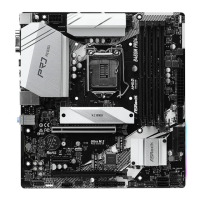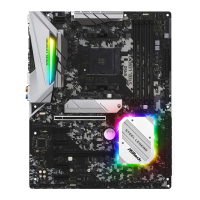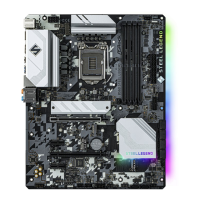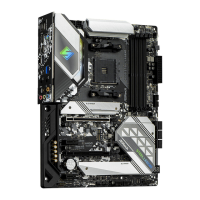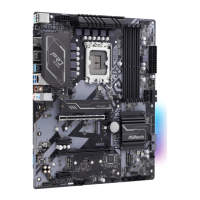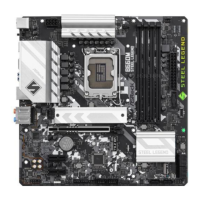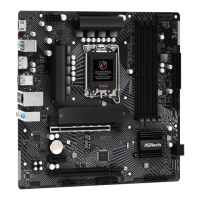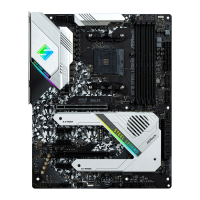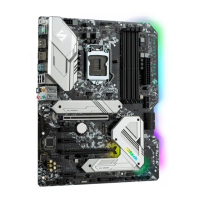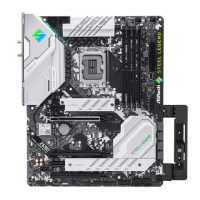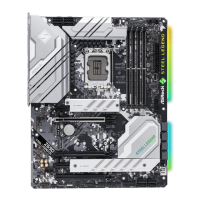
Do you have a question about the ASROCK B460 STEEL LEGEND and is the answer not in the manual?
| Audio chip | Realtek ALC1200 |
|---|---|
| Certification | FCC, CE, ErP/EuP |
| Component for | PC |
| Motherboard chipset | Intel B460 |
| PC health monitoring | FAN, Temperature, Voltage |
| Audio output channels | 7.1 channels |
| Motherboard form factor | ATX |
| Motherboard chipset family | Intel |
| Windows operating systems supported | Windows 10 x64 |
| Cables included | SATA |
| Drivers included | Yes |
| DisplayPort version | 1.4 |
| PS/2 ports quantity | 1 |
| DVI-D ports quantity | 0 |
| USB 2.0 ports quantity | 2 |
| USB 3.2 Gen 1 (3.1 Gen 1) Type-A ports quantity | 3 |
| Number of SATA III connectors | 6 |
| RAID levels | 0, 1, 5, 10 |
| Supported storage drive interfaces | SATA III |
| OpenGL version | 4.5 |
| DirectX version | 12.0 |
| Maximum resolution | 4096 x 2304 pixels |
| Parallel processing technology support | 2-Way CrossFireX, Quad-GPU CrossFireX |
| Wi-Fi | No |
| LAN controller | Dragon RTL8125BG |
| Ethernet interface type | 2.5 Gigabit Ethernet |
| BIOS type | UEFI AMI |
| ACPI version | 6.0 |
| BIOS memory size | 128 Mbit |
| System Management BIOS (SMBIOS) version | 2.7 |
| Memory slots type | DIMM |
| Number of memory slots | 4 |
| Supported memory types | DDR4-SDRAM |
| Maximum internal memory | 128 GB |
| Supported memory clock speeds | 2133, 2400, 2666, 2800, 2933 MHz |
| Processor socket | LGA 1200 (Socket H5) |
| Compatible processor series | Intel Celeron, Intel Core i3, Intel Core i5, Intel Core i7, Intel Core i9, Intel Pentium |
| Depth | 244 mm |
|---|---|
| Width | 305 mm |
Lists all items included with the ASRock B460 Steel Legend motherboard.
Details the technical specifications of the motherboard, including CPU, Memory, and Expansion Slots.
Diagram illustrating the physical layout and location of key components on the motherboard.
Explains the rear panel connectors and their functions for external connectivity.
Key safety and handling guidelines before installing components.
Step-by-step instructions for safely installing the Central Processing Unit (CPU) into the motherboard socket.
Instructions for mounting the CPU fan and heatsink assembly onto the motherboard.
Detailed guide on properly installing DDR4 DIMM memory modules into the motherboard slots.
Information on utilizing PCI Express slots for installing expansion cards like graphics cards.
Explanation of jumper settings, including the Clear CMOS jumper, for system configuration.
Description of various onboard headers and connectors for internal system components.
Explains the Post Status Checker for diagnosing system boot and hardware status.
Guide to installing and configuring multiple graphics cards using AMD CrossFireX technology.
Step-by-step process for installing two CrossFireX-ready graphics cards.
Instructions for installing necessary drivers and software for multi-GPU configurations.
Instructions for installing an M.2 NVMe or SATA SSD into the M2_1 slot.
Instructions for installing an M.2 NVMe or SATA SSD into the M2_2 slot.
Guide for installing an M.2 WiFi and Bluetooth module into the M2_3 slot.
Guide to installing essential system drivers from the support CD or other sources.
Instructions for installing and using the ASRock A-Tuning utility for system monitoring and fan control.
Overview of the ASRock APP Shop for downloading software, apps, and system updates.
Details on configuring the Nahimic audio software for enhanced sound and microphone performance.
Guide to customizing motherboard RGB lighting effects using ASRock Polychrome SYNC.
Overview of the UEFI SETUP UTILITY and instructions on how to access it.
Explanation of the EZ Mode BIOS interface for quick system status checks.
Guide to navigating and using the Advanced Mode BIOS settings and menu bar.
Description of the system information displayed on the UEFI Main screen.
Detailed guide to the OC Tweaker section for adjusting system performance and overclocking.
Overview of the Advanced screen providing access to detailed system configuration options.
Configuration options for the CPU, including Hyper-Threading, C-States, and core management.
Settings related to the motherboard chipset, including PCIe speeds and memory controllers.
Options for configuring SATA controllers, M.2 slots, and RAID modes.
Configuration options for Intel Thunderbolt support, including bootability and USB functions.
Configuration of ACPI settings for system power management and sleep states.
Settings for controlling USB ports, legacy support, and XHCI functionality.
Configuration for BIOS security features, including Secure Boot and TPM support.
Access to various tools within the UEFI setup, such as Instant Flash and network configuration.
View real-time hardware status, including temperatures, fan speeds, and voltages.
Options for setting supervisor and user passwords and configuring Secure Boot.
Settings to configure boot order, boot devices, and boot-related options.
Options for saving changes, discarding changes, and exiting the UEFI setup utility.
